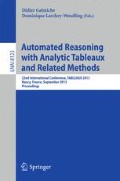Abstract
Which modal logics can be ‘naturally’ captured by a sequent system? Clearly, this question hinges on what one believes to be natural, i.e. which format of sequent rules one is willing to accept. This paper studies the relationship between the format of sequent rules and the corresponding syntactical shape of axioms in an equivalent Hilbert-system. We identify three different such formats, the most general of which captures most logics in the S5-cube. The format is based on restricting the context in rule premises and the correspondence is established by translating axioms into rules of our format and vice versa. As an application we show that there is no set of sequent rules of this format which is sound and cut-free complete for S5 and for which cut elimination can be shown by the standard permutation-of-rules argument.
Supported by EPSRC-Project EP/H016317/1.
Access this chapter
Tax calculation will be finalised at checkout
Purchases are for personal use only
Preview
Unable to display preview. Download preview PDF.
References
Avron, A., Lahav, O.: Kripke semantics for basic sequent systems. In: Brünnler, K., Metcalfe, G. (eds.) TABLEAUX 2011. LNCS (LNAI), vol. 6793, pp. 43–57. Springer, Heidelberg (2011)
Blackburn, P., de Rijke, M., Venema, Y.: Modal Logic. Cambridge University Press (2001)
Brünnler, K.: Deep sequent systems for modal logic. Arch. Math. Log. 48, 551–577 (2009)
Chellas, B.F.: Modal Logic. Cambridge University Press (1980)
Ciabattoni, A., Galatos, N., Terui, K.: Algebraic proof theory for substructural logics: Cut-elimination and completions. Ann. Pure Appl. Logic 163, 266–290 (2012)
Ciabattoni, A., Lahav, O., Spendier, L., Zamansky, A.: Automated support for the investigation of paraconsistent and other logics. In: Artemov, S., Nerode, A. (eds.) LFCS 2013. LNCS, vol. 7734, pp. 119–133. Springer, Heidelberg (2013)
Gentzen, G.: Untersuchungen über das logische Schließen. I. Math. Z. 39(2), 176–210 (1934)
Ghilardi, S.: Unification in intuitionistic logic. J. Symb. Log. 64(2), 859–880 (1999)
Goré, R.: Cut-free sequent and tableau systems for propositional diodorean modal logics. Studia Logica 53, 433–457 (1994)
Kracht, M.: Power and weakness of the modal display calculus. In: Wansing, H. (ed.) Proof Theory of Modal Logic, pp. 93–121. Kluwer (1996)
Lellmann, B., Pattinson, D.: Cut elimination for shallow modal logics. In: Brünnler, K., Metcalfe, G. (eds.) TABLEAUX 2011. LNCS (LNAI), vol. 6793, pp. 211–225. Springer, Heidelberg (2011)
Lellmann, B., Pattinson, D.: Constructing cut free sequent systems with context restrictions based on classical or intuitionistic logic. In: Lodaya, K. (ed.) ICLA 2013. LNCS (LNAI), vol. 7750, pp. 148–160. Springer, Heidelberg (2013)
Negri, S.: Proof analysis in modal logic. J. Philos. Logic 34, 507–544 (2005)
Negri, S., von Plato, J.: Structural proof theory. Cambridge University Press (2001)
Poggiolesi, F.: Gentzen Calculi for Modal Propositional Logic. Trends in Logic, vol. 32. Springer, Heidelberg (2011)
Troelstra, A.S., Schwichtenberg, H.: Basic Proof Theory. Cambridge Tracts in Theoretical Computer Science, 2nd edn., vol. 43. Cambridge University Press (2000)
Author information
Authors and Affiliations
Editor information
Editors and Affiliations
Rights and permissions
Copyright information
© 2013 Springer-Verlag Berlin Heidelberg
About this paper
Cite this paper
Lellmann, B., Pattinson, D. (2013). Correspondence between Modal Hilbert Axioms and Sequent Rules with an Application to S5. In: Galmiche, D., Larchey-Wendling, D. (eds) Automated Reasoning with Analytic Tableaux and Related Methods. TABLEAUX 2013. Lecture Notes in Computer Science(), vol 8123. Springer, Berlin, Heidelberg. https://doi.org/10.1007/978-3-642-40537-2_19
Download citation
DOI: https://doi.org/10.1007/978-3-642-40537-2_19
Publisher Name: Springer, Berlin, Heidelberg
Print ISBN: 978-3-642-40536-5
Online ISBN: 978-3-642-40537-2
eBook Packages: Computer ScienceComputer Science (R0)

